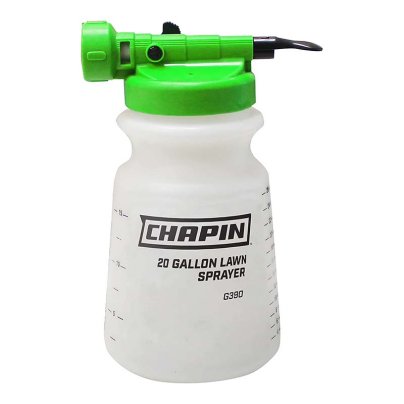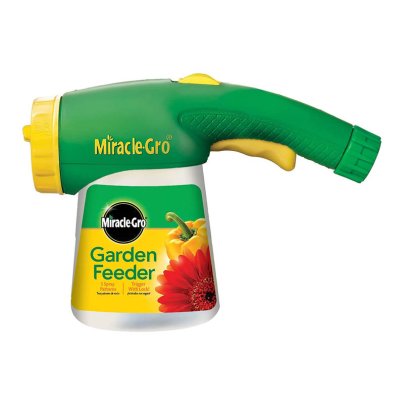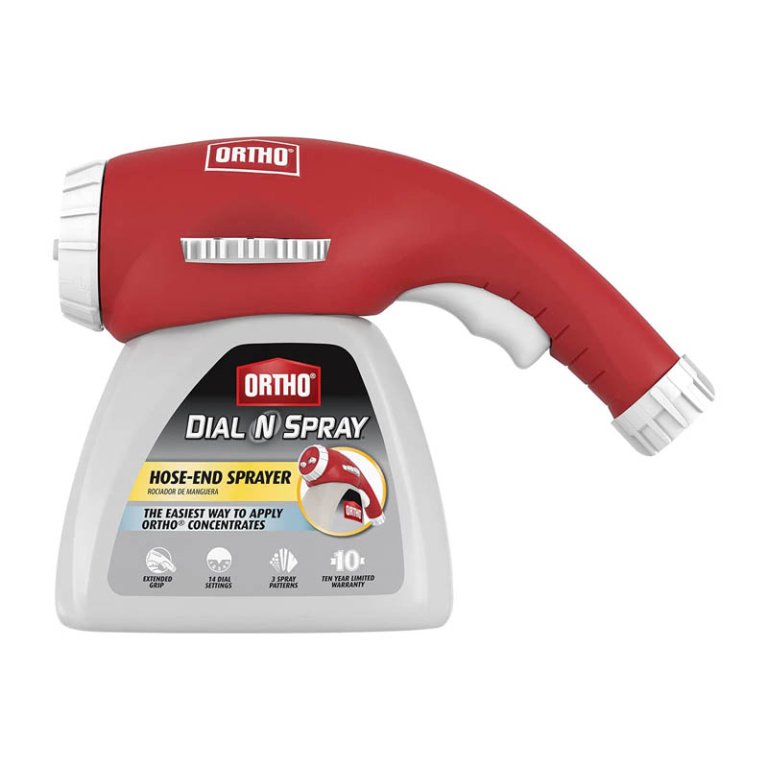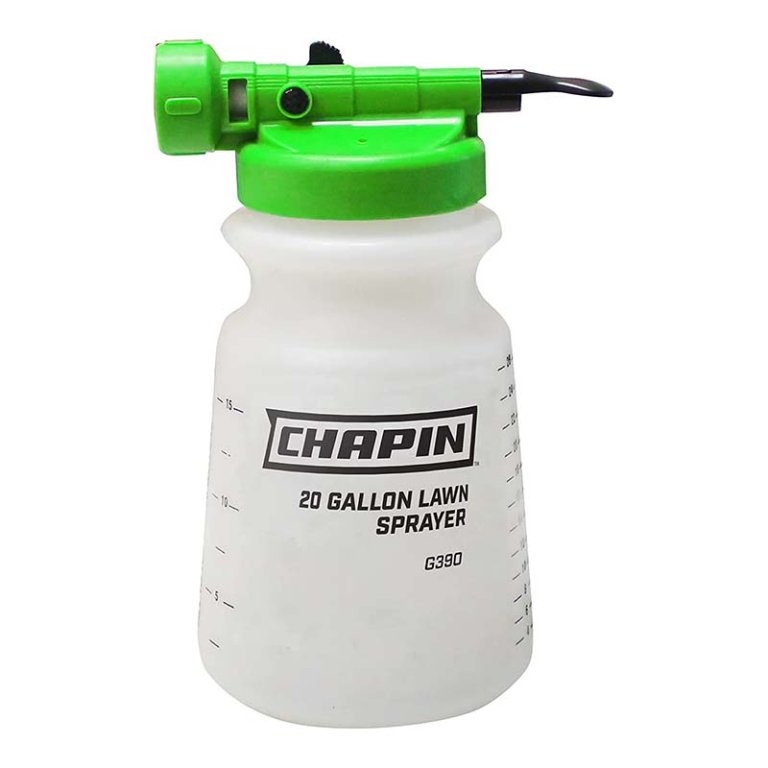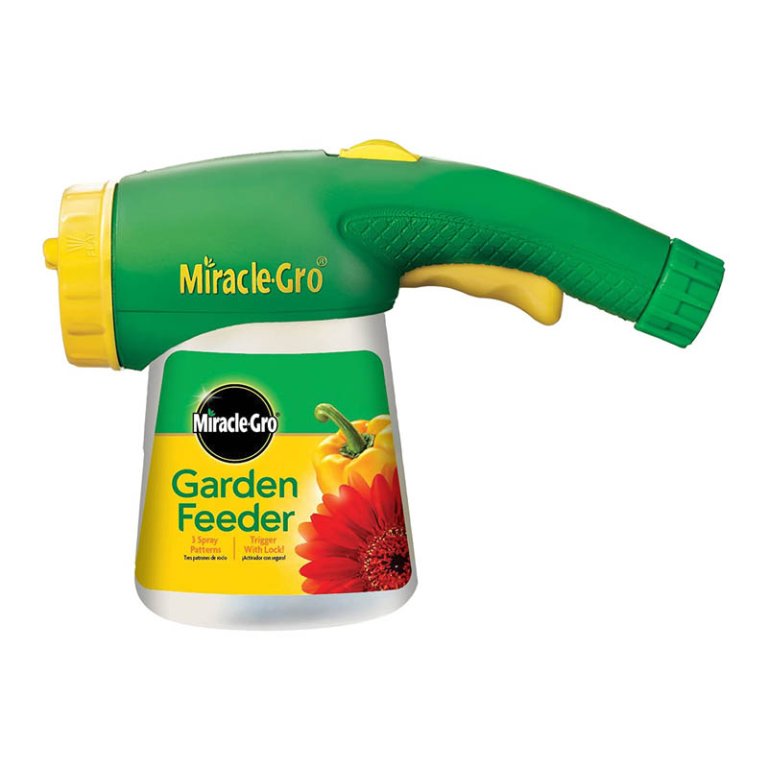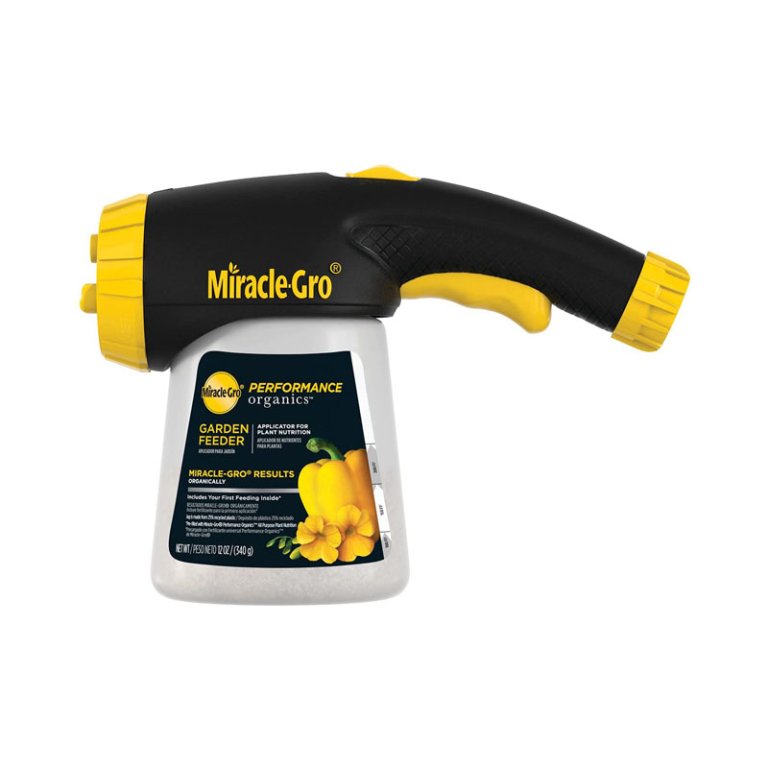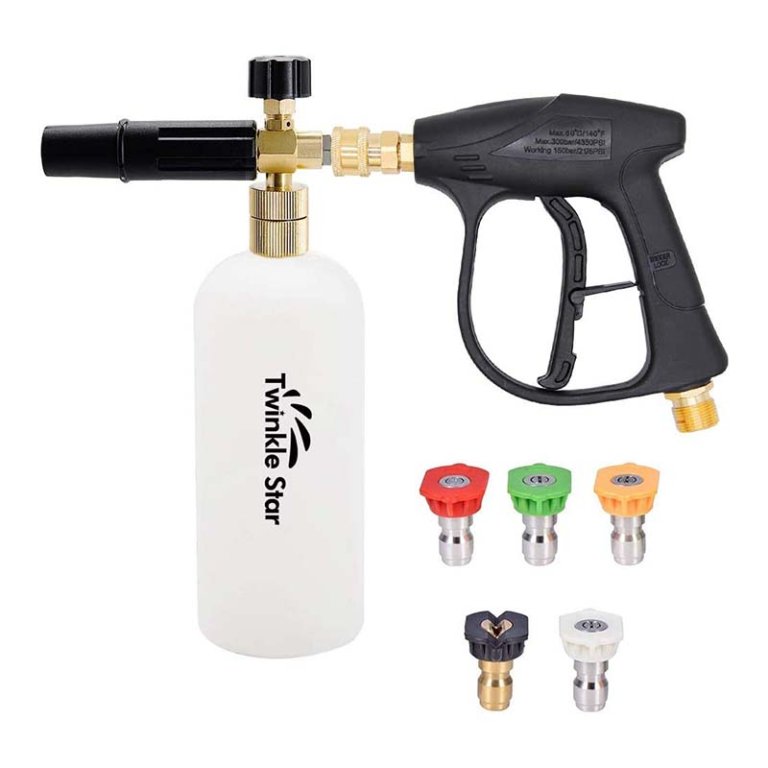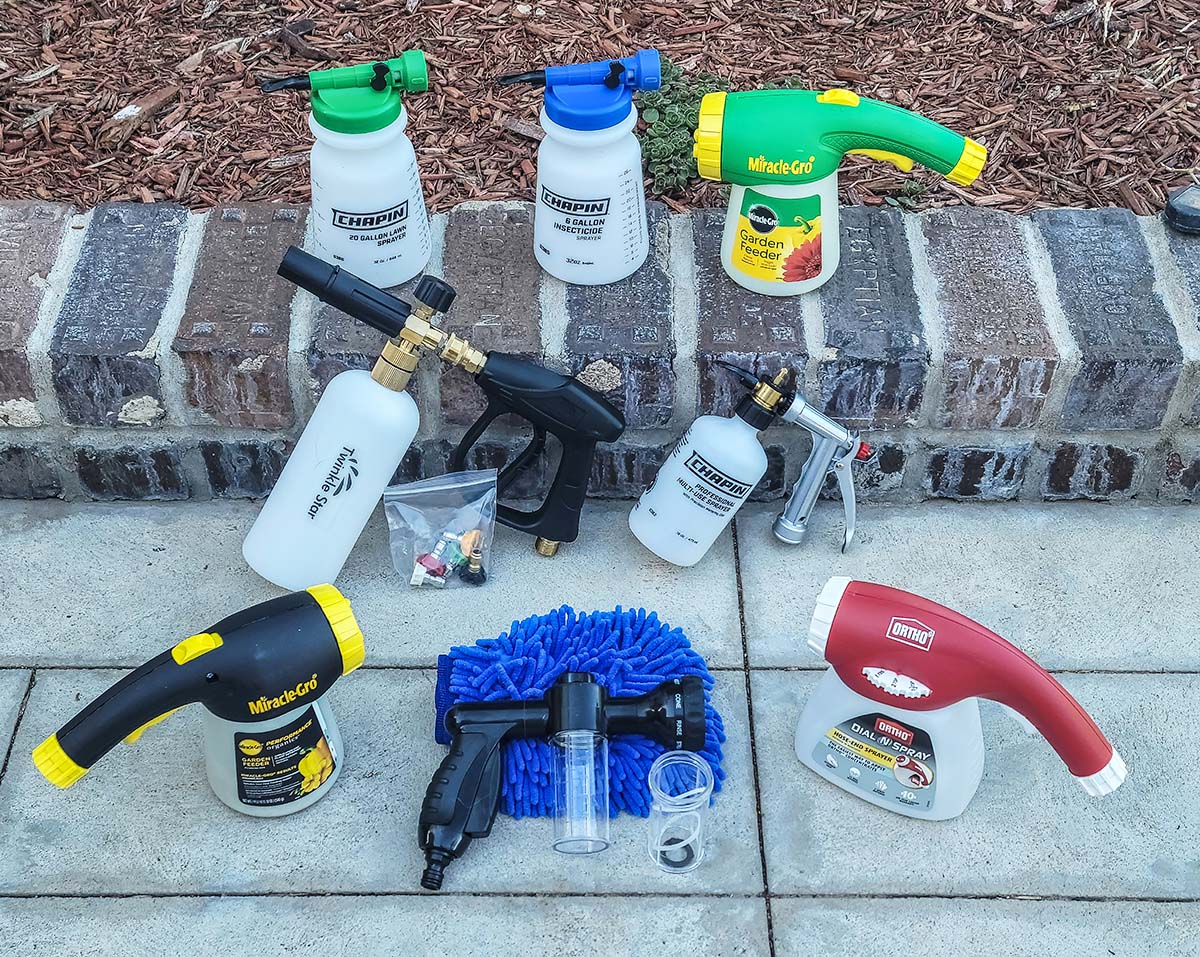
We may earn revenue from the products available on this page and participate in affiliate programs. Learn More ›
We understand that when it comes to gardening and fertilizing a yard, maintaining a row of shrubbery, tending to a flower bed, or nurturing a vegetable garden, handheld spray bottles may not be sufficient for the task. That’s why we decided to test today’s best-selling hose-end sprayers and provide our readers with comprehensive insights into how each one performed.
Hose-end sprayers harness the force of water pressure to efficiently dispense pesticides and fertilizers over large yards, gardens, and landscaping within minutes. These devices typically consist of a plastic container attached to a nozzle that connects to a standard garden hose. The nozzle effectively blends the chemicals from the container with water, enabling precise spraying onto targeted areas of the landscape. Our favorite is the Ortho Dial N Spray Hose-End Sprayer thanks to its smart design, customizable options, and anti-backflow device.
Ahead, discover the most important features to look for when shopping for one of these handy sprayers, and find out how the following models earned a spot on our lineup of the best hose- end sprayers.
- BEST OVERALL: Ortho Dial N Spray Hose-End Sprayer
↓ Jump to Review - BEST BANG FOR THE BUCK: Chapin G390 32-Ounce Lawn & Garden Hose-End Sprayer
↓ Jump to Review - BEST FOR GARDEN: Miracle-Gro Liquid Concentrate Garden Feeder
↓ Jump to Review - BEST WITH FERTILIZER: Miracle-Gro Performance Organics Garden Feeder
↓ Jump to Review - BEST FOAMING: Twinkle Star 5-Nozzle Pressure Washer Foam Lance
↓ Jump to Review
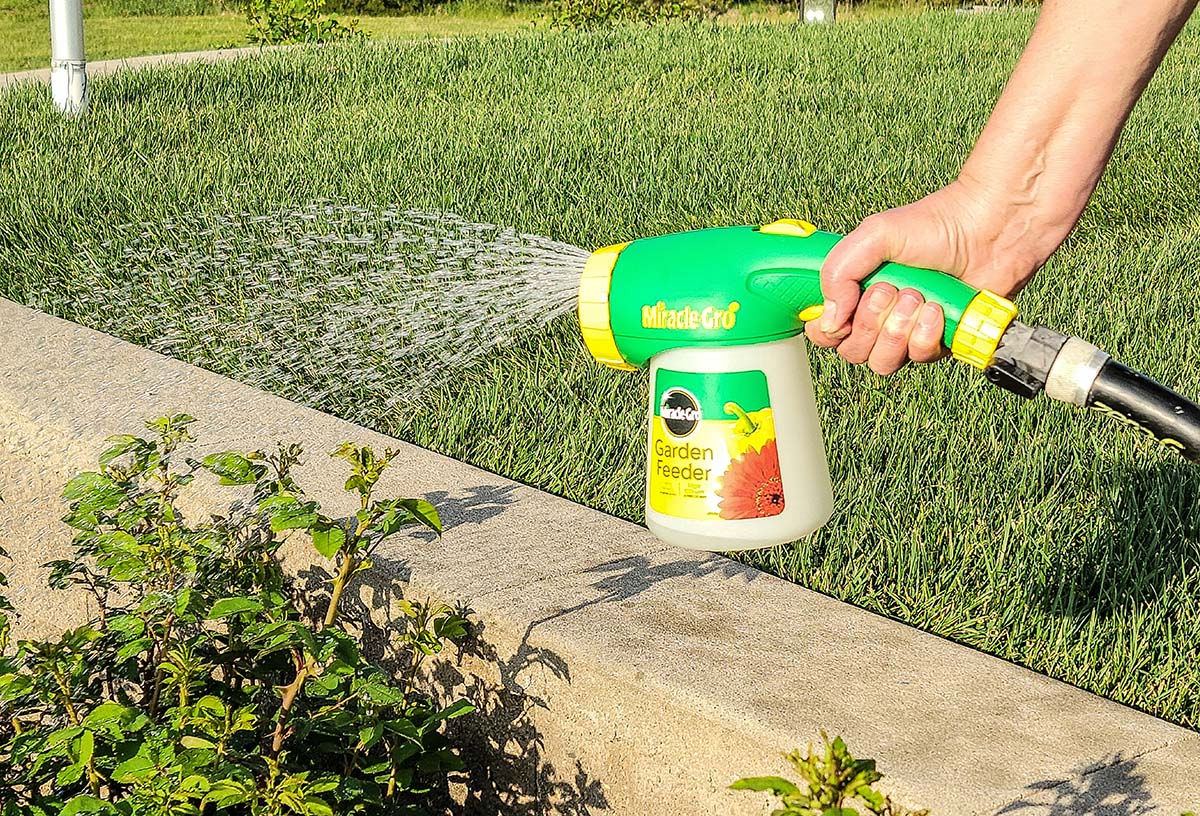
| Spray Patterns | Dilution Settings | Connects To | |
| Ortho Dial N Spray Hose-End Sprayer | 3 | 14 | Standard garden hose |
| Chapin G390 32-Ounce Lawn & Garden Hose-End Sprayer | 1 | None | Standard garden hose |
| Miracle-Gro Liquid Concentrate Garden Feeder | 3 | 0 (accommodates a 1.5-pound Miracle-Gro bag) | Standard garden hose |
| Miracle-Gro Performance Organics Garden Feeder | 3 | None | Standard garden hose |
| Twinkle Star 5-Nozzle Pressure Washer Foam Lance | 5 tips (plus twist adjustments) | Single knob for custom adjustment | Pressure-washer hose |
Our Top Picks
Below are the garden hose-end sprayers that excelled in our hands-on testing. This comprehensive lineup features a range of models in varying types, functions, and price points. Whether you’re seeking a versatile all-purpose sprayer or a specialized solution for specific gardening needs, you will find a valuable addition to your collection of gardening accessories among these top-performing options.
Best Overall
Ortho Dial N Spray Hose-End Sprayer
What We Like
- 3 spray patterns provide versatility for different application scenarios
- 14 dilution settings allow for customization of the strength of the solution
- Anti-backflow device prevents solution from flowing back into the hose
What We Don’t Like
- Spray coverage might not be adequate for large lawns or commercial use
Product Specs
- Spray patterns: 3
- Dilution settings: 14
- Connects to: Standard garden hose
Our Ratings: Ease of Use 4.5/5; Handle Comfort 4.5/5; Performance 5/5; Durability 5/5; Value 5/5
The Ortho Dial N Spray hose-end sprayer is a convenient and efficient tool for spraying liquid concentrates, such as weed killers, insect killers, fungicides, and fertilizers. With its easy-to-use design, this sprayer eliminates the hassle of mixing and measuring to prevent making a mess.
This garden hose-end sprayer offers just three spray patterns but covers most application bases. By twisting the ring at the front of the sprayer, we could select either a broadcast spray pattern, a strong jet stream, or a shower pattern for delicate foliage. Each worked well, but we discovered that our pattern selection had to be precise—you have to feel a little “click” when twisting the ring to ensure you get the pattern you want. If the ring fails to click into place, water dribbles profusely.
This durable Ortho sprayer offers 14 dilution settings from 1 teaspoon to 8 ounces per gallon of water. Simply use the adjustable dial on the sprayer’s side to customize solution strength to match application instructions on the fertilizer’s packaging. The sprayer’s anti-backflow device prevents any solution from flowing back into the water hose, ensuring it doesn’t contaminate the water in the garden hose. The ergonomically designed trigger and extended-grip handle are pretty standard, and they are similar in comfort to all the others we tested.
Read our full review: Ortho Dial N Spray Hose-End Sprayer
Get the Ortho hose-end sprayer at Amazon, The Home Depot, Walmart, Blain’s Farm & Fleet, or Ortho.
Best Bang For The Buck
Chapin G390 32-Ounce Lawn & Garden Hose-End Sprayer
What We Like
- Universal fit for easy attachment to any standard garden hose
- Built-in anti-siphon feature prevents backflow to prevent contamination of the water supply
- Capable of handling water-soluble chemicals as well as concentrated liquid products
What We Don’t Like
- No dilution adjustment—dilution is controlled by measuring the product before adding it to the tank
- On/off thumb lever is not as ergonomic as the design of some spray models
- Only offers a downward fan spray pattern, which isn’t practical for elevated or direct spraying
Product Specs
- Spray patterns: 1
- Dilution settings: None
- Connects to: Standard garden hose
Our Ratings: Ease of Use 4.5/5; Handle Comfort 3.5/5; Performance 4/5; Durability 5/5; Value 4/5
Tend to your lawn and garden without spending a lot of money. We found the affordable Chapin G390 lawn and garden sprayer a durable and reliable option for various spraying needs in our yard. It has a 32-ounce chemical-resistant poly tank and a universal fitting to attach easily to any standard garden hose.
One of the notable features of this sprayer is its capability to handle water-soluble chemicals. With this sprayer, we could add granulated fertilizer to the tank and apply it uniformly to our lawn. It also accepts liquid fertilizer and features a measurement guide on the side of the tank for accurate dilution. Like many hose-end sprayers we tested, the Chapin G390 has a built-in anti-siphon feature that ensures backflow prevention to keep from contaminating the water in the hose.
While the Chapin G390 performed well in our testing, it has a couple of minor downsides worth mentioning. The sprayer features a thumb lever on top, which feels less ergonomic than a traditional trigger design. We prefer a trigger-type sprayer for convenience. Plus, it offers only one spray pattern, limiting the versatility of application options. It’s best suited to lawns and low-growing flowers and shrubs due to the downward angle of the spray.
Considering its budget-friendly price point, the Chapin G390 hose-end sprayer is a reliable choice for those seeking a durable and practical sprayer for their yard. While it may have some minor ergonomic considerations and limited spray-pattern options, it delivers satisfactory performance in terms of spraying capability and ease of use.
Get the Chapin G390 hose-end sprayer at Amazon, Lowe’s, Tractor Supply Co., The Home Depot, or Walmart.
Best For Garden
Miracle-Gro Liquid Concentrate Garden Feeder
What We Like
- 3 spray patterns for custom product application to different plants
- Covers a significant area in a short amount of time, providing efficient feeding
- Offers the option to store unused solution in the plastic tank for future feeding
What We Don’t Like
- Lock lever on the top required significant force and was difficult to use; may not be as user-friendly as some other sprayers
- Feeder tends to leak if the hose fitting is not tightly secured, indicating potential issues with the inside washer
Product Specs
- Spray patterns: 3
- Dilution settings: 0 (accommodates a 1.5-pound Miracle-Gro bag)
- Connects to: Standard garden hose
Our Ratings: Ease of Use 3/5; Handle Comfort 4/5; Performance 3.5/5; Durability 4/5; Value 3.8/5
From a name well known in the gardening world comes the Miracle-Gro Garden Feeder, which features trigger-lock technology to allow for easy one-handed feedings. Similar in design to our Best Overall pick, the Miracle-Gro sprayer has three spray patterns (broadcast, shower, and jet). All three functioned well in our tests.
Using the Miracle-Gro Garden Feeder is a simple three-step process. First, add Miracle-Gro water-soluble plant food to the tank. Next, connect the feeder to the hose. And finally, start the fertilizing process by squeezing the trigger, which causes water to fill the tank and dilute the product.
In testing, the locking mechanism on the top of the Garden Feeder was somewhat challenging to operate. It tended to stick and required too much force to engage with just a thumb, which diminished its ease of use. Furthermore, we noticed that the sprayer tended to leak unless we tightened the hose fitting securely. This led us to suspect that the inside washer might not be of the highest quality.
The instructions suggested cleaning the jar by turning the feeder upside down after use and running water through it. This process took less than a minute, but the sprayer can also be stored with unused fertilizer still in the tank if desired.
Get the Miracle-Gro Garden Feeder hose-end sprayer at Amazon (sprayer only) or with fertilizer included at Ace Hardware, The Home Depot, Blain’s Farm & Fleet, or Miracle-Gro.
Best With Fertilizer
Miracle-Gro Performance Organics Garden Feeder
What We Like
- Offers 3 spray patterns for custom applications—broadcast, shower, and jet
- Quick cleaning by turning the feeder upside down and running water through the jar
- Straightforward process for connecting, filling, and operating the feeder
What We Don’t Like
- Lock lever on the top can be challenging to maneuver, requiring significant force
Product Specs
- Spray patterns: 3
- Dilution settings: None
- Connects to: Standard garden hose
Our Ratings: Ease of Use 3/5; Handle Comfort 4/5; Performance 4/5; Durability 4/5; Value 4/5
The Miracle-Gro Performance Organics Garden Feeder offers functionality and a design that’s similar to the preceding product on our list, the Miracle-Gro Garden Feeder. With trigger technology for one-handed feedings, this sprayer provides convenience and efficiency. It also includes three spray patterns—broadcast, shower, and jet—which all performed well during testing.
However, we encountered a familiar challenge with the lock lever on the top of the Garden Feeder. It proved to be difficult to maneuver, requiring considerable force to operate. The lack of ease of use, especially with the need for extra pressure, was a notable drawback.
Using the Miracle-Gro Performance Organics Garden Feeder is a straightforward three-step process. Fill the tank with fertilizer (the first fertilizer feeding is included), connect the sprayer to the hose, turn on the water, and start spraying.
We followed the instructions to clean the sprayer after use, which required us to turn it upside down and run water through the jar. This rinsing took less than a minute and cleared out all the fertilizer residue.
Get the Miracle-Gro Performance Organics hose-end sprayer at Amazon, Lowe’s, Ace Hardware, Blain’s Farm & Fleet, True Value, or Miracle-Gro.
Best Foaming
Twinkle Star 5-Nozzle Pressure Washer Foam Lance
What We Like
- Versatility with 5 different spray tips plus adjustment knob for various spray patterns
- Durable brass construction and nonslip grip for durability and comfort
- Adjustable foam thickness and water flow for customized cleaning
What We Don’t Like
- Requires a pressure washer with a minimum pressure of 1,500 PSI for proper use
Product Specs
- Spray patterns: 5 tips (plus twist adjustments)
- Dilution settings: Single knob for custom adjustment
- Connects to: Pressure-washer hose
Our Ratings: Ease of Use 4/5; Handle Comfort 5/5; Performance 5/5; Durability 5/5; Value 4/5
We found the Twinkle Star five-nozzle washer to be a great addition to our pressure-washer accessories. It comes with five different spray tips, allowing us to choose from various jet patterns, including 0 degree, 15 degree, 25 degree, 40 degree, and soap dispense. This versatility suits multiple applications, particularly when washing cars, farm equipment, and similar items.
The build quality is impressive—it features a brass neck, and the spray gun has a brass core covered with nonslip padding. It needs all that brass to withstand the high water pressure of a power washer.
A knob on the top gave us precise control over the water flow and foam thickness to customize the foam according to our specific needs. We were able to achieve a thick, rich foam that effectively lifted dirt and grime from the car and the tractor we cleaned with the Twinkle Star.
Using the Twinkle Star pressure washer was a straightforward process. We added concentrated liquid automobile-cleaning solution to the tank, then connected the ¼-inch quick-fitting connector to our pressure-washer hose. Be aware that this is not a suitable sprayer for a garden hose—it doesn’t come with the correct fittings—and it also requires a power washer with at least 1,500 PSI to generate foam.
Get the Twinkle Star hose-end sprayer at Amazon.
ALSO TESTED
We also tested the Chapin G385 Hose-End Sprayer, but unfortunately, it did not meet our expectations and therefore did not earn a spot on the lineup. While we had positive experiences with Chapin’s other sprayers in our test, it appears that this particular sprayer had an issue with its internal workings—perhaps it was dropped or damaged during shipping.
When we connected it to our hose and turned on the water, we noticed a significant water leak from two holes near the attachment fitting. We attempted to address the issue by replacing the washer, but the leaking persisted—and it was not just a little leak. The water ran profusely out of the holes, leaving no water pressure to spray out the garden hose nozzle. Although this very well might be an isolated incident and a fluke, we could not further test this specific Chapin model. However, we remain open to testing another Chapin sprayer in the future.
Jump to Our Top Picks
How We Tested the Best Hose-End Sprayers
| Testing Stats | |
| Products tested | 8 |
| Time spent testing | 1 hour each |
| Tests performed | 8 to 9 |
| Price range | $7 to $30 |
Before selecting hose-end sprayers for our hands-on tests, we extensively researched more than 30 different models, paying close attention to user ratings. We considered brand—after all, names like Ortho, Chapin, and Miracle-Gro have earned a reputation for manufacturing high-quality products. Still, we didn’t automatically eliminate smaller manufacturers or niche brands if the sprayer offered beneficial features and had high consumer approval.
In actual testing, we put each hose-end sprayer through its paces outside in a back or front yard. Most models connected to standard garden hoses, but we tested one foam sprayer with a pressure washer. We used a water pressure of 45 pounds per square inch (PSI) with each garden-hose sprayer, which we consistently measured using a water-pressure meter. We filled the garden-hose sprayers with the recommended fertilizer, while the foam sprayer was tested using an automobile-cleaning solution. We tried dilution settings and tested every spray pattern the sprayer offered to determine how well it functioned.
Using a rubric-based scoring system, we evaluated each sprayer. The better the sprayer performed, the higher the score. After testing, we added the points to determine which sprayers earned a place in the lineup and which didn’t.
| Ease of Use | Handle Comfort | Performance | Durability | Value | |
| Ortho Dial N Spray Hose-End Sprayer | 4.5/5 | 4.5/5 | 5/5 | 5/5 | 5/5 |
| Chapin G390 32-Ounce Lawn & Garden Hose-End Sprayer | 4.5/5 | 3.5/5 | 4/5 | 5/5 | 4/5 |
| Miracle-Gro Liquid Concentrate Garden Feeder | 3/5 | 4/5 | 3.5/5 | 4/5 | 3.8/5 |
| Miracle-Gro Performance Organics Garden Feeder | 3/5 | 4/5 | 4/5 | 4/5 | 4/5 |
| Twinkle Star 5-Nozzle Pressure Washer Foam Lance | 4/5 | 5/5 | 5/5 | 5/5 | 4/5 |
What to Consider When Choosing a Hose-End Sprayer
Selecting a hose-end sprayer to satisfy specific needs depends upon various factors. For example, while some sprayers mix a fixed amount of chemicals with each gallon of water, others allow the user to set the mix ratio. Ahead, learn more about mix ratio and other vital attributes to remember when shopping for the best hose-end sprayer.
Material
Hose-end sprayers are made of plastic, polyurethane, and metal parts. Virtually all sprayers use polypropylene (a type of plastic) reservoirs or jars to hold the chemicals they mix with water to create fertilizers, pesticides, herbicides, and other lawn and plant treatments. This is because polypropylene is lightweight, won’t rust like metal, and can withstand acid and other chemicals without melting.
Sprayer nozzles may be made of either plastic or metal. Plastic nozzles are lighter and more affordable, but they are less durable than metal nozzles. They give way more quickly to high water pressure and are more likely to crack if dropped or stepped on. Most pro-grade sprayers have metal nozzles. Peggy Anne Montgomery, veteran horticulturist from Garden Media Group in Chester County, Pennsylvania, offers some advice: “Buy the best you can afford and take good care of them. It will be cheaper in the end.”
Fixed Rate vs. Adjustable Flow
There are two types of sprayers: fixed rate and adjustable flow. Both types work by siphoning chemicals from the sprayer’s reservoir and mixing the chemicals with water before distributing the solution into the yard.
Fixed-rate sprayers siphon a specific amount of chemicals from the reservoir, whereas adjustable-flow sprayers allow the user to control how much chemical is mixed with water. With an adjustable-flow sprayer, you decide how much fertilizer, pesticide, or other chemicals the sprayer applies. Adjustable-flow sprayers are typically more expensive than fixed-rate models.
Capacity
A hose-end sprayer’s capacity determines how much area it can treat before requiring a refill. The capacity is based on two factors: the amount of product the reservoir can hold and the ratio of chemicals to water the sprayer uses. Hose-end sprayer reservoirs usually hold between 16 and 32 ounces of liquid chemicals. Higher-capacity sprayers can treat wider areas, such as lawns, trees, and long rows of shrubbery, while smaller models are suitable for vegetable gardens and flower beds.
Remember that a sprayer set to a higher chemicals-to-water ratio will produce a more concentrated pesticide, fertilizer, or weed-killer solution, but it will empty the reservoir more quickly than a sprayer set to a lower concentration.
Spray Settings
Hose-end sprayers are similar in function to many hose nozzles,allowing you to adjust the flow pattern of the water by twisting a knob or a nozzle tip. Typically, they’ll have up to four spray patterns ranging from a light mist to a narrow, high-pressure stream. These adjustments control the amount of fertilizer, herbicide, or inoculants the sprayer distributes in the yard, on trees, or onto flower beds.
According to Montgomery, shoppers will want to look for versatile spray settings to cover a range of gardening uses. “When watering plants, a gentle flow of water is always best. If you’re cleaning the mower deck, you want strong pressure. Some nozzles have several settings and that could be the best choice if you are only going to get one.”
These settings can also control the range of the sprayer. A spray pattern that produces higher pressure will be strong enough to reach the branches of trees, whereas a lighter spray will be gentle enough to apply pesticide to a flower bed without damaging the plants.
- Mist: This setting produces the least output and the lightest pressure setting. The mist setting aerates the water to produce a fine mist that floats in the air over a short distance. This setting is ideal for treating delicate plants, such as flowers and vegetables.
- Shower: The shower setting most closely mimics rain. This pattern has a longer range and higher output than mist while still producing gentle pressure that won’t damage smaller plants. It’s suitable for treating lawns, gardens, shrubs, and flower beds with hardier plants.
- Foaming: The foaming setting is meant to be used with soap or certain types of pesticides. The nozzle agitates the chemical or soap and water to produce a sudsy lather. This makes it ideal for washing a car or for certain pesticide applications.
- Long spray: Treating tall trees requires a spray pattern that can reach all the way to the upper branches. Long spray condenses the stream to increase water pressure, enabling the sprayer to reach heights up to 30 feet.
Mix Ratios
When the water hose passes through the sprayer’s nozzle, it dilutes the chemicals from the reservoir before gushing forth from the nozzle’s business end. The dilution ratio determines how much of the chemicals in the reservoir the sprayer releases into the water as it passes through the nozzle.
Fixed-rate sprayers use a set ratio that the user cannot change, while sprayers with an adjustable flow have a dial that lets the user tweak the mix ratio. To alter the ratio in a fixed-rate sprayer, one must dilute the chemicals in a separate container prior to adding them to the reservoir.
Hose-end sprayers may feature dials that allow the user to adjust the ratio of water to chemicals. These dials are usually set by ounces of chemicals per gallon of water. Many adjustable flow sprayers allow you to set the mix ratio from 1 ounce of chemicals per gallon of water up to 14 ounces per gallon of water. Most fertilizers, pesticides, and weed killers have instructions detailing the correct ratio for the product.
Hose-end sprayers are handy and practical, but they’re not as precise as pump sprayers, where the user mixes a specific amount of product in water and adds it to the sprayer tank. If you’re concerned about getting too much or too little weed killer or pesticide, you might be better off going with a pump sprayer and mixing the solution by hand.
Additional Features
Many hose nozzles have additional features designed to make them easier to operate.
- Ergonomic handles: Ergonomically designed handles have a curved shape for a comfortable grip while directing the nozzle at a downward angle suited to treating gardens, shrubs, and lawns.
- Self-mixing functionality: Sprayers with a self-mixing feature eliminate the need to premix chemicals prior to adding them to the reservoir. Some mixers are even compatible with dry chemicals. Convenient thumb dials on self-mixing sprayers let the operator adjust the mix ratio on the fly.
- User-friendly controls: Some models include a thumb-operated on/off button that allows the user to shut off the sprayer with just the flick of the thumb, eliminating the need to run back to the hose faucet to shut down the sprayer.
- Quick-connect attachments: Screwing a sprayer onto and off the hose end can be tedious every time the lawn needs treatment. Sprayers with a quick-connect design replace the standard fitting with a connection that pops on or off the sprayer in seconds.
Hose Compatibility
Hose-end sprayers are compatible with standard 1-inch garden-hose fittings and work best with a ⅝-inch diameter hose, allowing enough water flow to create adequate pressure. Some sprayers also have quick-connect fittings, making attaching and detaching them easier.
The Advantages of Using a Hose-End Sprayer
Hose-end sprayers are an affordable way to improve the efficiency of applying pesticides, weed control, and fertilizers to yards, trees, landscaping, and gardens. Here’s a breakdown of the advantages of these handy tools.
- Many don’t require premixing chemicals. Many hose-end sprayers do the mixing for you, allowing you to add chemicals directly to the reservoir. This minimizes mess and exposure to harmful chemicals.
- They don’t require pumping. Pump-style sprayers require you to constantly create pressure inside the tank by pumping up the unit. Hose-end sprayers use the pressure created by running water, eliminating the need for pumping.
- They can cover a large area. Perhaps the greatest advantage of a hose-end sprayer is its ability to cover thousands of square feet relatively quickly. These products are the best option for treating larger areas, such as lawns.
FAQs
If you’re wondering how to best use and maintain your hose-end sprayer, read on for answers to some of the most commonly asked questions about these tools.
A hose-end sprayer consists of a reservoir that holds chemicals for treating landscaping and a nozzle that distributes the water. It uses a standard hose fitting that connects to a standard garden hose. When the hose turns on, the water runs through the nozzle, which mixes chemicals with water before spraying it.
A hose-end sprayer can hold between 16 and 32 ounces of chemicals and distribute about 2 gallons of treated water per minute at a standard home water pressure of 60 PSI.
Most hose-end sprayers dilute water at ratios between 1 ounce and 16 ounces of chemicals per gallon. Adjustable-flow sprayers allow you to set the mix ratio.
To use a hose-end sprayer, begin by setting the mix ratio to the desired amount. Follow the fertilizer or pesticide instructions to get the proper mix ratio. Ensure the sprayer is in the “off” position, then turn on the hose at the spigot. Turn the sprayer to the “on” position and evenly spray the area to treat. Some sprayers come with a lock that allows you to use the sprayer as a garden-hose nozzle—spraying just water, not a chemical solution.
There are two ways to apply liquid fertilizer: Either add the liquid fertilizer to the sprayer’s reservoir or, if compatible, attach the bottle of liquid fertilizer directly to the hose-end sprayer’s nozzle by removing the reservoir and attaching the bottle.
To clean a hose-end sprayer, rinse the reservoir with clean water, then fill it. Attach the sprayer to the hose, then run the sprayer to clear it out, just as you would a garden-hose nozzle. Other than rinsing to clean, hose-end sprayers typically require very little maintenance.
Meet the Tester
Glenda Taylor is a product tester and writer specializing in the construction, remodeling, and real estate industries. She and her husband own a general contracting company, and Taylor is experienced in both residential and commercial building applications. She tests a wide range of power tools as well as other home improvement, household, and lawn-and-garden products.
Additional research was provided by Tony Carrick.

